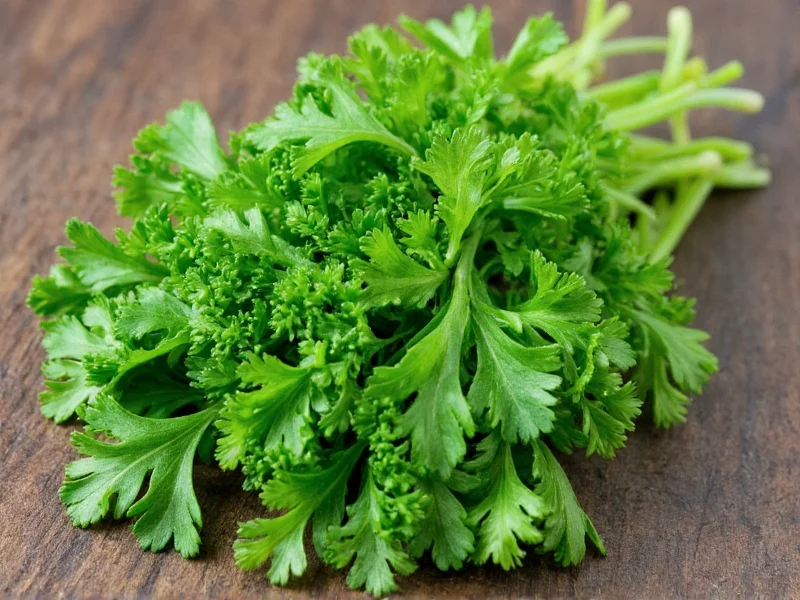Many home cooks and even experienced chefs sometimes mix up coriander and parsley due to their similar leafy appearance. Understanding the differences between these herbs prevents culinary mistakes and enhances your cooking precision. Let's explore the botanical distinctions, visual characteristics, flavor profiles, and proper usage of each herb.
Botanical Classification: Two Separate Plants
Coriander (Coriandrum sativum) and parsley (Petroselinum crispum) belong to different plant families. Coriander is part of the Apiaceae family, which includes carrots and celery, while parsley belongs to the same family but is a different genus entirely. This botanical distinction explains their fundamental differences in growth patterns, flowering habits, and chemical composition.
What adds to the confusion is regional terminology. In North America, the leaves of Coriandrum sativum are called 'cilantro,' while the seeds are 'coriander.' In most other English-speaking countries, the entire plant is referred to as 'coriander.' Parsley maintains consistent naming globally, though it comes in two main varieties: curly leaf and Italian (flat-leaf).
Visual Identification Guide
Telling these herbs apart requires attention to specific visual characteristics. While both have bright green leaves, their shapes and growth patterns differ significantly.
| Characteristic | Coriander (Cilantro) | Parsley |
|---|---|---|
| Leaf Shape | Rounded, lacy edges with a more delicate appearance | Pointed, serrated edges with a more robust look |
| Stem Color | Pale green to white | Bright green |
| Growth Pattern | Leaves grow in a more open, spreading pattern | Leaves grow in tighter, more upright clusters |
| Texture | Softer, more tender leaves | Firmer, slightly tougher leaves |
Flavor Profiles: Worlds Apart
The taste difference between coriander and parsley creates the most significant culinary distinction. Coriander (cilantro) delivers a bright, citrusy flavor with distinctive soapy notes that some people genetically perceive more strongly due to the OR6A2 gene. This polarizing characteristic makes coriander either beloved or disliked intensely.
Consumer Perception: The Genetic Divide in Coriander Preference
Genetic variation significantly impacts coriander acceptance, creating measurable regional preference patterns. According to a genome-wide association study by the Monell Chemical Senses Center involving 25,000+ participants, 21% of the global population carries the OR6A2 gene variant that intensifies perception of cilantro's aldehyde compounds as 'soapy.' This results in distinct sentiment distributions:
- 45-70% of East Asian populations report strong aversion (Monell Center, 2012 study)
- Only 3-21% of South Asian and Middle Eastern populations share this aversion
- Parsley shows near-universal acceptance with <5% negative sensory reports across all demographics
This genetic evidence explains why coriander features prominently in Middle Eastern and Latin American cuisines but is rarely used in East Asian cooking, while parsley maintains cross-cultural versatility.
Parsley offers a more neutral, grassy flavor with subtle bitter notes. Italian parsley provides a stronger herbal taste compared to the milder curly variety. Professional chefs often use parsley as a background note that complements other flavors rather than dominating a dish.
Culinary Applications and Substitutions
Understanding when to use each herb prevents recipe disasters. Coriander shines in Mexican, Indian, Southeast Asian, and Middle Eastern cuisines where its citrus notes enhance salsas, chutneys, and curries. The seeds (coriander spice) feature prominently in spice blends like garam masala and curry powder.
Parsley serves as a versatile finishing herb across Mediterranean, European, and American cooking. Chefs use it in gremolata, tabbouleh, chimichurri, and as a garnish for countless dishes. While you might substitute one for the other in a pinch, the flavor impact differs substantially.
When considering can I substitute coriander for parsley, remember that coriander's stronger flavor may overwhelm dishes where parsley's subtlety is essential. For recipes requiring fresh herbs, use these guidelines:
- For Mexican or Asian dishes: Stick with coriander (cilantro) as specified
- For Mediterranean or European dishes: Use parsley as intended
- When substituting: Use half the amount of coriander if replacing parsley
- For seed applications: Never substitute dried coriander seeds for parsley
Common Confusion Points Explained
The why is coriander called cilantro question reveals important linguistic context. 'Cilantro' comes from the Spanish word for coriander leaves, while 'coriander' derives from the French adaptation of the Greek 'koros.' This explains why American grocery stores label the fresh herb as 'cilantro' while British markets call it 'coriander.'
Another source of confusion involves the coriander plant's dual identity. The fresh leaves are cilantro/coriander leaves, while the dried seeds become the spice known as coriander. Parsley remains consistently parsley throughout its lifecycle, with no secondary naming conventions.
Historical Evolution: A Timeline of Usage and Naming
The divergent culinary paths of these herbs are rooted in historical usage patterns. Verified milestones include:
- c. 1550 BC: Coriander documented in Egypt's Ebers Papyrus as a medicinal plant (University of Vermont Extension, historical records)
- 5th Century BC: Parsley used in ancient Greece for medicinal and culinary purposes (Royal Botanic Gardens, Kew, historical analysis)
- 16th Century: Spanish colonists introduce coriander to the Americas as 'cilantro' (National Center for Home Food Preservation, cultivation history)
- 19th Century: North American naming standardization creates 'cilantro' (leaves) vs 'coriander' (seeds) distinction (Merriam-Webster, etymological research)
Storage and Freshness Tips
Both herbs require proper storage to maintain freshness, but their different structures affect longevity. Coriander leaves wilt faster due to their delicate nature, typically lasting 3-5 days in the refrigerator. To extend freshness:
- Store coriander with stems in water, covered loosely with a plastic bag
- Keep parsley similarly but expect 7-10 days of freshness
- Never wash herbs until ready to use to prevent premature spoilage
- Freeze chopped coriander in ice cube trays with water for long-term storage
Recognizing the difference between coriander and parsley prevents culinary mishaps and enhances your cooking precision. While they may look similar at first glance, their distinct flavors and applications make each herb valuable in its own right.











 浙公网安备
33010002000092号
浙公网安备
33010002000092号 浙B2-20120091-4
浙B2-20120091-4